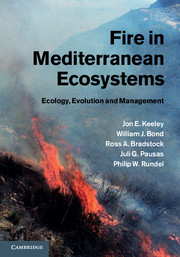6 - Fire in Chile
from Section II - Regional patterns
Published online by Cambridge University Press: 05 January 2012
Summary
The Mediterranean-type Climate Region of Chile
The mediterranean-type climate (MTC) in Chile (Fig. 6.1) is distributed from La Serena (30° S; Región IV, see Appendix 6.1) in the north to Concepción (37° S; Región X) in the south. It is constrained to the west side of the Andean mountain range, although as the height of this range decreases in the south, a MTC is observed at least as far eastward as Bariloche, Argentina. Although a pattern of winter rains and summer droughts extends northward into the Atacama Desert, this area falls outside our definition of MTC because winter evaporation exceeds rainfall in these areas of extremely low precipitation. The northern border of the MTC region is the transition from desert communities to shrubby matorral, while the southern border corresponds to the point of transition from sclerophyll woodlands to Valdivian evergreen forests (Gajardo 1994; Amigo & Ramirez 1998; Rundel et al. 2007).
The landforms of central Chile can be divided into three north–south trending geomorphic zones (Fig. 6.1): the Coastal Cordillera, the Central Valley, and the high Andean Cordillera (Armesto et al. 2007). The Coastal Cordillera rises relatively sharply from the coast, with little extent of coastal terraces, and reaches elevations as high as 2222 m at Cerro Roble and 1880 m at Cerro Campana, which lie between Valparaíso (Región V) on the coast and Santiago (Región Metropolitana) at the base of the Andes. The Central Valley is a structural basin filled to great depth by sediments from the surrounding mountains. North of Santiago, spurs from the Andes extend west across the valley and connect with the Coastal Cordillera, separating individual river basins such as that of the Río Aconcagua (Región V). From Santiago to the south, however, the valley extends uninterrupted for a distance of 900 km to Puerto Montt (Región X), with typical elevations of 400–700 m. The Andean Cordillera marks the eastern boundary of the MTC zone of central Chile. It is the product of complex tectonic activity beginning in the Cretaceous (see Fig. 9.1), but with major uplift in the late Tertiary. Paleobotanical evidence suggests that the central Andes had not attained more than half their current elevation by 10 Ma (Gregory-Wodzicki 2000), but was close to the present height by the end of the Miocene (Reynolds et al. 1990). Elevations reach from 4000 m to nearly 7000 m. To the north of Santiago the Andes are largely composed of metamorphosed sedimentary rock, but a major volcanic zone extends from south of Santiago through the Lake District (Los Lagos Región X).
- Type
- Chapter
- Information
- Fire in Mediterranean EcosystemsEcology, Evolution and Management, pp. 150 - 167Publisher: Cambridge University PressPrint publication year: 2011



